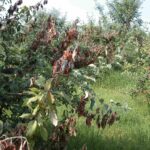With last week’s thunderstorms and severe weather, fire blight continues to threaten crops: Hail can physically damage the tree and allow entry of the bacteria (Fig. 1) and secondary spread of the pathogen.
Secondary spread of fire blight develops when stormy weather (especially hailstorms) occurs after the primary (blossom) infections. The amount of fire blight that develops after severe weather appears to be directly related to the amount of disease in the orchard, with inoculum levels highest near infected blossoms, cankers, or blighted shoots that were not previously removed (Fig. 2). Keep in mind that early freeze damage was an ideal infection court for the fire blight bacterium. During severe weather, wind-driven rain easily spread the bacteria throughout the orchard.
- Figure 1. Trauma blight in a poorly maintained orchard. Photo by George Sundin.
- Figure 2. Blossom blight in Gala, 2023. Photo by Janna Beckerman.
At this point, growers should monitor their orchards for fire blight strikes, removing any and all infected shoots, sterilizing between cuts, if the incidence of the disease makes this possible. Growers can use a can of Lysol or a spray bottle of 10% bleach, or any other disinfectant (trisodium phosphate, quaternary ammonium compounds), to sterilize between cuts, as poor sterilization techniques can inadvertently spread fire blight. Keep in mind that pruning of large trees may be impractical because of the difficulty of doing a thorough job of blight removal.
At this stage in the season, pruning should NOT stimulate additional shoot growth as we are in the dormant season with little risk of spreading disease. I do not recommend the “ugly stub method” (where large chunks of tree are removed, but long stubs are left to mark where additional pruning should be done in the spring). Subsequent studies have shown mixed results with this approach, which still leaves fire blight inoculum present, and presents an excellent infection court for black rot, white rot and other opportunistic pathogens. The rapid and complete removal of fire blight strikes is the only proven method to limit secondary spread and is essential for minimizing loss. That said, keep in mind that pruning may not be effective during severe fire blight outbreaks, and that the bacteria spreads more than 12” past the symptomatic tissue (Fig. 1, 2), so cuts should extend at least 18” past symptomatic tissue, and ideally to where a good pruning cut can be made.
It is important to stress that THE ONLY effective chemical control for trauma blight currently available is streptomycin. Streptomycin needs to be applied within 4 to 12 hours to maximize control, especially if there are active fire blight cankers or strikes in the orchard or if the trauma event resulted in extensive foliar damage. The sooner streptomycin can be applied after the event the more effective it is in killing the bacteria before they infect and spread. Do not apply streptomycin later than 18 hr. The repeated use of streptomycin sprays after petal fall encourages the selection of streptomycin-resistant Erwinia amylovora, the bacterium that causes fire blight. We don’t need to add Indiana to the list of states with strep-resistant E. amylovora (Missouri, California, Washington, Oregon, New York and Michigan). Finally, streptomycin should never be sprayed as a preventive measure for shoot blight. This is not an effective use of this material and only promotes the development of streptomycin-resistant strains. The best use of streptomycin is to prevent the infection of blossom blight, followed by trauma blight, when applied within ~12 hours.
The fire blight bacteria rarely comes in with these storms, which means the problem was already present in the orchard. If your orchard has a history of fire blight, I would strongly encourage you to consider applying Apogee or Kudos (Prohexadione-Ca) for spring of 2024 (instructions begin on page 19 of the Midwest Fruit Pest Management Guide, with additional information on page 47). Apogee is a growth regulator that does not directly kill the fire blight bacterium, but reduces shoot growth, thereby increasing plant resistance by reducing host vigor. Apogee suppresses apple shoot growth when applied near petal fall as a single spray, or as several applications over time. Apple response to Apogee depends upon the cultivar, timing, rate of application, crop load, and even geographical location. Regardless of this variability, Apogee remains one of the best management tools available for controlling the shoot blight phase of fire blight after a freeze or trauma like hail, and should be considered for next year.
Finally, fire blight resistant apple and pear varieties (root stocks and cultivars) are a great way to minimize reliance on pesticides. For a list of these varieties (and which are highly susceptible, see the Fire Blight Extension bulletin for more information.

